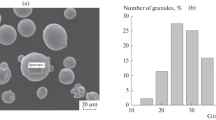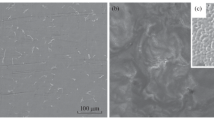Abstract
Selective laser melting (SLM), its features, advantages, and disadvantages are discussed. The materials and parts fabricated by this technique are shown to be anisotropic and heterogeneous in their physical and mechanical properties. An ultrajet diagnostic technique is proposed as a method for estimating the quality of SLM parts. Possible estimation of the anisotropy of properties using ultrajet diagnostics is demonstrated using samples grown from a Ti6Al4V titanium alloy with horizontal and vertical orientations in a chamber. The experimental data prove the existence of a relation between the informative features of local surface hydroerosion of an SLM material and its structural and anisotropic features. The dominant harmonic of Fourier analysis of the hydrocavity microrelief on an SLM sample is found to be similar to the laser melting geometry of the initial dispersed powder material.







Similar content being viewed by others
REFERENCES
N. P. Aleshin, M. V. Grigor’ev, N. A. Shchipakov, M. A. Prilutskii, and V. V. Murashov, “Applying nondestructive testing to quality control of additive manufactured parts,” Russ. J. Nondestr. Test. 52 (10), 600–609 (2016).
N. P. Aleshin, M. V. Grigor’ev, N. A. Shchipakov, M. A. Prilutskii, and V. V. Murashov, “Using nondestructive testing methods for in-production quality control of additive manufactured parts,” Russ. J. Nondestr. Test. 52 (9), 532–537 (2016).
N. P. Aleshin, V. V. Murashov, A. G. Evgenov, M. V. Grigor’ev, N. A. Shchipakov, S. A. Vasilenko, and I. S. Krasnov, “The classification of flaws of metal materials synthesized by the selective laser melting method and the capabilities of nondestructive testing methods for their detection,” Russ. J. Nondestr. Test. 52 (1), 38–43 (2016).
N. P. Aleshin, M. V. Grigor’ev, O. A. Krupnina, and N. A. Shchipakov, “Some specific features of studying additive-manufactured parts by X-ray computed tomography,” Russ. J. Nondestr. Test. 54 (4), 271–277 (2018).
A. A. Popovich et al., “Mechanical anisotropy of products manufactured by selective laser melting of powder materials,” Izv. Vyssh. Uchebn. Zaved. Poroshk. Metall. Funkts. Pokrytiya, No. 3, 4–11 (2016).
M.-W. Wu, P.-H. Lai, and J.-K. Chen, “Anisotropy in the impact toughness of selective laser melted Ti–6Al–4V alloy,” Mater. Sci. Eng. A. 650, 295–299 (2016).
GOST R (State Standard) 57587–2017: Additive Manufacturing Products. Control and Testing Techniques.
GOST R (State Standard) 57556–2017: Materials for Additive Technological Processes. Control and Testing Techniques.
W. J. Sames et al., “The metallurgy and processing science of metal additive manufacturing,” Int. Mater. Rev. 61 (5), 315–360 (2016).
W. J. Sames et al., “Thermal effects on microstructural heterogeneity of Inconel 718 materials fabricated by electron beam melting,” J. Mater. Res. 29 (17), 1920–1930 (2014).
X. Zhao et al., “Comparison of the microstructures and mechanical properties of Ti–6Al–4V fabricated by selective laser melting and electron beam melting,” Mater. Des. 95, 21–31 (2016).
X. Wang and K. Chou, “Residual stress in metal parts produced by powder-bed additive manufacturing processes,” in Proceedings of the 26th International Solid Freeform Fabrication Symposium (2015), pp. 1463–1474.
P. Mercelis and J.-P. Kruth, “Residual stresses in selective laser sintering and selective laser melting,” Rapid Prototyping J. 12 (5), 254–265 (2006).
B. Ferrar et al., “Gas flow effects on selective laser melting (SLM) manufacturing performance,” Mater. Process. Technol. 212 (2), 355–364 (2012).
N. T. Aboulkhair et al., “Reducing porosity in Al–Si10Mg parts processed by selective laser melting,” Addit. Manuf. 1–4, 77–86 (2014).
L. N. Carter et al., “The influence of the laser scan strategy on grain structure and cracking behavior in SLM powder-bed fabricated nickel superalloy,” J. Alloys Compd. 615, 338–347 (2014).
L. Thijs et al., “A study of the microstructural evolution during selective laser melting of Ti–6Al–4V,” Acta Mater. 58 (9), 3303–3312 (2010).
T. Ishimoto et al., “Crystallographic texture control of beta-type Ti–15Mo–5Zr–3Al alloy by selective laser melting for the development of novel implants with a biocompatible low Young’s modulus,” Scr. Mater. 132, 34–38 (2017).
L. Thijs et al., “Fine-structured aluminum products with controllable texture by selective laser melting of prealloyed AlSi10Mg powder,” Acta Mater. 61 (5), 1809–1819 (2013).
L. Thijs et al., “Strong morphological and crystallographic texture and resulting yield strength anisotropy in selective laser melted tantalum,” Acta Mater. 61 (12), 4657–4668 (2013).
H. Helmer et al., “Grain structure evolution in Inconel 718 during selective electron beam melting,” Mater. Sci. Eng. A. 668, 180–187 (2016).
I. A. Barabonova et al., “Selective laser melting of corrosion-resistant steel,” in Modern Techniques and Technologies for Creating and Processing. Materials Science, Ed. by A. V. Belyi (FTI NAN, Belarus, Minsk, 2017), pp. 6–11.
A. Okunkova et al., “Experimental approbation of selective laser melting of powders by the use of nonGaussian power density distributions,” Phys. Procedia 56, 48–57 (2014).
D. S. Kolchanov, “Development of equipment and technology for growing products by selective laser melting of stainless steel powders,” Cand. Sci. (Eng.) Dissertation, Bauman State Technical University, 2018.
N. P. Karapatis and G. Egger, “Optimization of powder layer density in selective laser sintering,” in 10th Solid Freeform Fabrication Symposium (1999), pp. 255–263.
A. B. Spierings et al., “Powder flowability characterization methodology for powder-bed-based metal additive manufacturing,” Prog. Addit. Manuf. 1 (1), 9–20 (2016).
A. B. Spierings and G. Levy, “Comparison of density of stainless steel 316L parts produced with selective laser melting using different powder grades,” in 20th Annual International Solid Freeform Fabrication Symposium (2009), pp. 342–353.
X. Tan et al., “An experimental and simulation study on build thickness dependent microstructure for electron beam melted Ti–6Al–4V,” J. Alloys Compd. 646, 303–309 (2015).
M. Seifi et al., “Overview of materials qualification needs for metal additive manufacturing,” JOM 68 (3), 747–764 (2016).
S. M. Kelly and S. L. Kampe, “Microstructural evolution in laser-deposited multilayer Ti–6Al–4V builds: Part II. Thermal modeling,” Met. Mater. Trans. A 35 (6), 1869–1879 (2004).
A. A. Popovich, D. V. Masaylo, V. Sh. Sufiiarov, E. V. Borisov, I. A. Polozov, V. A. Bychenok, I. Yu. Kinzhagulov, I. V. Berkutov, D. S. Ashikhin, and A. V. Il’inskii, “A laser ultrasonic technique for studying the properties of products manufactured by additive technologies,” Russ. J. Nondestr. Test. 54 (6), 3–10 (2016).
A. A. Barzov, A. L. Galinovskii, and I. E. Kuznetsov, “Application of ultrajet diagnostics and quality control of products,” Vest. Ufim. Gos. Aviats. Tekh. Univ., 12 (4), 121–126 (2009).
M. I. Abashin, A. L. Galinovskii, and V. A. Shuteev, “Ultrajet express diagnostics of materials and products of mechanical engineering,” Nauchno-Tekh. Vedomosti S.-Peterb. Gos. Politekh. Univ. 141–147 (2011).
M. I. Abashin, A. L. Galinovskii, and L. V. Sudnik, “Determination of the hardness and wear resistance of steel samples by the ultrajet method,” Izv. Vyssh. Uchebn. Zaved. Mashinostr. No. 3, 73–79 (2013).
“Specifications: RenAM 500M additive manufacturing system”. URL: http://resources.renishaw.com/ru/details/renam-500m-89988. Date of access: August 22, 2018.
Author information
Authors and Affiliations
Corresponding author
Additional information
Translated by T. Gapontseva
Rights and permissions
About this article
Cite this article
Barzov, A.A., Galinovskiy, A.L., Golubev, E.S. et al. Ultrajet Diagnostics of the Structural and Anisotropic Features of the Parts Fabricated by Selective Laser Melting. Russ. Metall. 2021, 794–800 (2021). https://doi.org/10.1134/S0036029521060069
Received:
Revised:
Accepted:
Published:
Issue Date:
DOI: https://doi.org/10.1134/S0036029521060069




